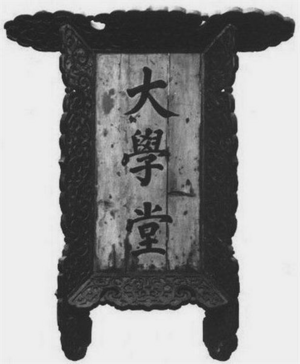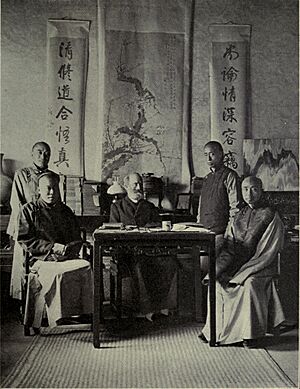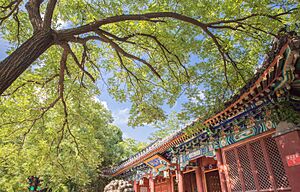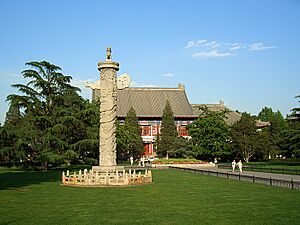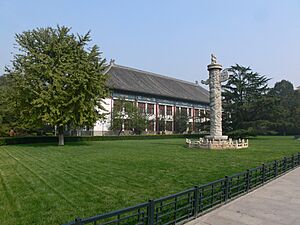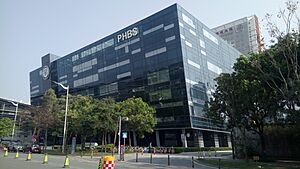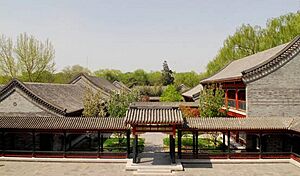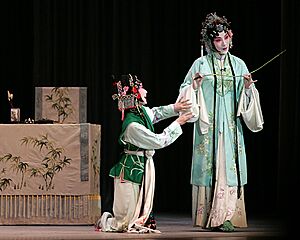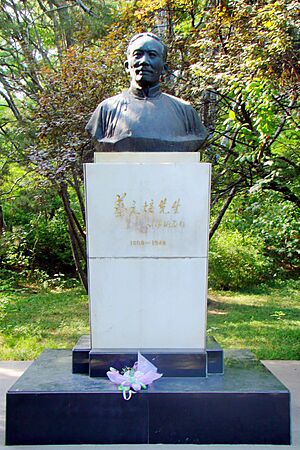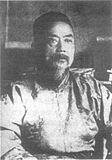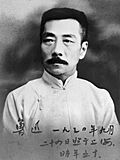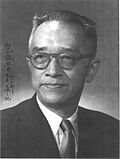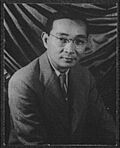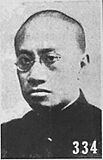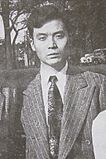Peking University facts for kids
|
北京大学
|
|||||||||||||||||||||||
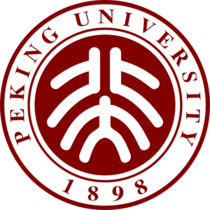
Seal
|
|||||||||||||||||||||||
|
Former names
|
Imperial University of Peking | ||||||||||||||||||||||
|---|---|---|---|---|---|---|---|---|---|---|---|---|---|---|---|---|---|---|---|---|---|---|---|
| Type | Public | ||||||||||||||||||||||
| Established | 1898 | ||||||||||||||||||||||
| President | Gong Qihuang | ||||||||||||||||||||||
| Party Secretary | Hao Ping | ||||||||||||||||||||||
|
Academic staff
|
11,337 | ||||||||||||||||||||||
| Students | 44,730 | ||||||||||||||||||||||
| Undergraduates | 16,060 | ||||||||||||||||||||||
| Postgraduates | 28,670 | ||||||||||||||||||||||
| Location |
Haidian, Beijing
,
China
39°59′23″N 116°18′19″E / 39.98972°N 116.30528°E |
||||||||||||||||||||||
| Campus | 274 ha (680 acres) | ||||||||||||||||||||||
| Colours | Red | ||||||||||||||||||||||
| Affiliations | C9, IARU, AALAU, AEARU, APRU, BESETOHA, BHUA | ||||||||||||||||||||||
| Website | |||||||||||||||||||||||
| Chinese name | |||||||||||||||||||||||
| Simplified Chinese | 北京大学 | ||||||||||||||||||||||
| Traditional Chinese | 北京大學 | ||||||||||||||||||||||
|
|||||||||||||||||||||||
| Abbreviation | |||||||||||||||||||||||
| Chinese | 北大 | ||||||||||||||||||||||
|
|||||||||||||||||||||||
Peking University (often called PKU) is a famous public university in Haidian, Beijing, China. It is supported by the Chinese Ministry of Education. PKU is part of special programs like the C9 League, which includes China's top universities.
The university started in 1898 as the Imperial University of Peking. It was created by the Guangxu Emperor. This makes it one of the oldest universities in China. In 1912, its name changed to Peking University. Later, it joined with other universities, like Yenching University in 1952 and Beijing Medical University in 2000.
Peking University has six main areas of study: Humanities, Social Sciences, Economics and Management, Science, Information Technology and Engineering, and Health Science. It has many schools, departments, and research centers. By 2017, many top scientists and experts worked there.
Contents
History of Peking University
How it Started
After China lost a war, smart thinkers like Kang Youwei wanted to improve education. In 1898, the Guangxu Emperor allowed the creation of the Imperial University of Peking. It was meant to be the country's best place for higher learning. William Alexander Parsons Martin became its first president. Even though some changes were stopped by the Empress Dowager Cixi, the university still opened in December 1898 with 160 students.
After a big change in China in 1912, the university was renamed "Government University of Peking." Then, in 1919, it became "National University of Peking."
Important Years (1916–1927)
In 1917, a famous scholar named Cai Yuanpei became president. He helped Peking University grow a lot. He believed in academic freedom, like in German universities. He brought in many smart teachers with different ideas. These included important figures from the New Culture Movement, like Hu Shih and Chen Duxiu.
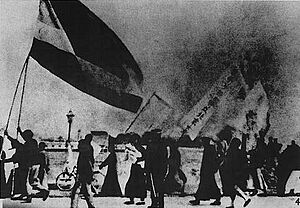
On May 1, 1919, students at Peking University learned about a treaty that would give Japan rights in China. On May 4, students from many universities marched to Tiananmen Square to protest. They wanted the government to refuse to sign the treaty. This protest, known as the May Fourth Movement, led to big changes. The government eventually listened to the students and fired some officials. China also refused to sign the treaty.
World War Two (1938–1946)
During World War II, Peking University joined with other universities to form the National Southwestern Associated University. This temporary university was in Kunming, Yunnan. It was a very productive time for Chinese thinkers.
Recent Times (2000–present)
In 2015, a former student and professor from Peking University, Tu Youyou, won the Nobel Prize in Physiology or Medicine. She discovered a medicine called artemisinin that saves millions of lives from malaria.
Peking University has continued to grow and partner with other universities around the world. In 2017, it signed a deal with the Open University to create a campus in Oxford. In 2020, it helped set up the Sino-Russian Mathematics Center. New campuses and schools have also opened, like the Changping campus in 2021 and the School of Integrated Circuits.
In 2022, Peking University worked with The Lancet to study healthy aging in China. They looked at how older people can keep contributing to society. Also in 2022, Peking University was the only Chinese university to get a platinum certification from the International University Sports Federation for its "Healthy Campus" program.
Campus Life and Buildings
The university campus used to be imperial gardens. It still has beautiful Chinese-style gardens, old houses, and pagodas. An American architect, Talbot Hamlin, designed some of the buildings built between 1919 and 1922.
The West Gate is very famous for its painted murals. Weiming Lake is a lovely spot in the north of the campus, with walking paths and small gardens. The university also has museums, like the Museum of University History and the Arthur M. Sackler Museum of Art and Archaeology. These museums display ancient items, including burial objects and jewelry from thousands of years ago.
Peking University also has other campuses. The Health Science Center is on Xueyuan Road, a street known for many colleges. In 2001, the Shenzhen Graduate School opened in Shenzhen City.
Images for kids
Academics and Research
Peking University has many schools and departments. It offers a wide range of subjects for students studying for their first degree, master's degrees, and doctorates. Besides basic research, the university also works on applied research, which means finding practical uses for scientific discoveries.
The university has many research centers and national laboratories. Its library is the largest university library in Asia, with 8 million books and other items. Peking University also works with other top universities, like the Georgia Institute of Technology and Emory University, on special programs.
Many former students of Peking University have become presidents of other major Chinese universities. This shows how important PKU is in shaping education in China.
University Rankings
| University rankings | |
|---|---|
| Global – Overall | |
| ARWU World | 24 |
| QS World | 14 |
| QS Employability | 23 |
| THE World | 13 |
| THE Reputation | 11 |
| USNWR Global | 25 |
| Regional – Overall | |
| ARWU Asia | 2 |
| QS Asia | 1 |
| QS BRICS | 2 |
| THE Asia | 2 |
| THE Emerging Economies | 1 |
Peking University is consistently ranked among the top universities in China and the world. In 2015, it was considered the best Chinese university by the Chinese University Alumni Association.
As of 2024, it was ranked 16th globally when combining several major university rankings. In 2006, it was ranked 14th in the world and 1st in Asia and Oceania by the THE-QS World University Rankings. The U.S. News & World Report ranked it 39th globally in 2014.
In 2023, the QS Rankings placed Peking University 12th in the world and first in Asia. In 2024, the Times Higher Education World University Rankings ranked it 13th globally. The "Shanghai Ranking" (ARWU) placed it 24th in the world. For 2025, U.S. News & World Report ranked Peking University 25th in the world.
Peking University is also known for its graduates' job prospects. In 2017, it was ranked 11th globally for how easily its graduates find jobs. Since 2017, it has been among the top 20 most respected universities in the world.
Research Achievements
Peking University is a leader in research. In 2020, it was ranked 8th in the world for its research publications. For high-quality research in science and health, it ranked 5th among top institutions globally in the Nature Index 2025 Research Leaders. In 2024, it was 7th among universities worldwide by SCImago Institutions Rankings. In November 2024, it was ranked 12th globally for having many highly cited researchers.
Shenzhen Graduate School
The Peking University Shenzhen Graduate School is a branch campus in Shenzhen, Guangdong. It opened in 2001 and works with the Shenzhen government. It is part of the University Town of Shenzhen, which also has other top universities. This campus has several research schools, including the Peking University HSBC Business School.
In 2016, Peking University and the Shenzhen government agreed to expand the Shenzhen Graduate School. They plan to build a new campus and offer undergraduate programs there.
International Partnerships
Every year, about 7,000 international students come to study at Peking University. The university has many partnerships with universities around the world.
For example, it has special programs with Waseda University in Japan. Students can earn two bachelor's degrees, one from each university. They also have joint master's and doctoral programs. This kind of full partnership is rare globally.
PKU also works with Cornell University and Yale University in the United States. Students from these universities can study at Peking University for a semester. The School of International Studies has joint degree programs with the London School of Economics and Seoul National University. Peking University also has a long-standing relationship with Stanford University, which has a research center on the PKU campus.
Global Excellence Plan
On its 121st anniversary, Peking University announced its "Global Excellence Strategy." This plan aims to make PKU even more globally recognized. It focuses on working with international partners, sharing resources, and encouraging teamwork. The strategy uses the word "CLOUDS" to represent its goals: creativity, leadership, openness, uniqueness, diversity, and shaping the future.
Art Research
Peking University is involved in many art research projects. It works with the University of Chicago on the Center for the Art of East Asia. It also partners with UNESCO on digital art and design.
Famous People from Peking University
Famous Alumni
Many important people have studied at Peking University. These include:
- Leaders: Li Keqiang, a former premier of China.
- Scientists: Tu Youyou, who won the Nobel Prize for her work on malaria medicine. Also, nuclear physicists like Qian Sanqiang and Deng Jiaxian, who helped with China's nuclear program. Zhong Nanshan, a famous doctor who helped fight diseases.
- Writers and Thinkers: Lu Xun, a leading figure in modern Chinese literature. Hu Shih, a famous philosopher. Lin Yutang, a writer and inventor.
- Business Leaders: Robin Li, who co-founded Baidu, a major internet company.
- Other Notables: Hou Yifan, a world-champion chess player. Ding Liren, another world-champion chess player.
-
Gu Hongming, translator and educator.
-
Lu Xun, leading figure of modern Chinese literature.
-
Lin Yutang, Chinese writer, linguist, inventor, and translator.
-
Former Premier of China, Li Keqiang (LLB, PhD)
-
Nobel laureate Tu Youyou, pharmaceutical chemist and educator, recipient of the 2015 Nobel Prize in Physiology or Medicine.
-
Co-founder and CEO of Baidu, billionaire Robin Li (BSc, Information Management, 1991)
-
Four-time Women's World Chess Champion, Hou Yifan (BA, International Relations, 2018)
-
World Chess Champion and highest-rated Chinese chess player in history, Ding Liren (BA, Law)
-
Mathematician and MacArthur Fellow Yitang Zhang (BA 1982, MA 1984)
Notable Staff
Peking University has also had many important teachers and staff. Mao Zedong, who later founded the People's Republic of China, worked in the university library.
Cai Yuanpei, the university's second president, was a key figure. He brought new ideas from European universities to China. He also strongly supported freedom of speech for his staff and students.
See also
 In Spanish: Universidad de Pekín para niños
In Spanish: Universidad de Pekín para niños
- 7072 Beijingdaxue – an asteroid named after Peking University
- Affiliated High School of Peking University
- History of Beijing


